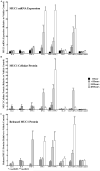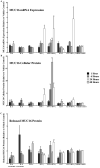Effect of pro-inflammatory mediators on membrane-associated mucins expressed by human ocular surface epithelial cells
- PMID: 20036239
- PMCID: PMC2880853
- DOI: 10.1016/j.exer.2009.12.009
Effect of pro-inflammatory mediators on membrane-associated mucins expressed by human ocular surface epithelial cells
Abstract
Membrane-associated mucins are altered on the ocular surface in non-Sjögren's dry eye. This study sought to determine if inflammatory mediators, present in tears of dry eye patients, regulate membrane-associated mucins MUC1 and -16 at the level of gene expression, protein biosynthesis and/or ectodomain release. A human corneal limbal epithelial cell line (HCLE), which produces membrane-associated mucins, was used. Cells were treated with interleukin (IL)-6, -8, or -17, tumor necrosis factor-alpha (TNF-alpha), and Interferon-gamma (IFN-gamma), or a combination of TNF-alpha and IFN-gamma, or IFN-gamma and IL-17, for 1, 6, 24, or 48 h. Presence of receptors for these mediators was verified by RT-PCR. Effects of the cytokines on expression levels of MUC1 and -16 were determined by real-time PCR, and on mucin protein biosynthesis and ectodomain release in cell lysates and culture media, respectively, by immunoblot analysis. TNF-alpha and IFN-gamma each significantly induced MUC1 expression, cellular protein content and ectodomain release over time. Combined treatment with the two cytokines was not additive. By comparison, one of the inflammatory mediators, IFN-gamma, affected all three parameters-gene expression, cellular protein, and ectodomain release-for MUC16. Combined treatment with TNF-alpha and IFN-gamma showed effects similar to IFN-gamma alone, except that ectodomain release followed that of TNF-alpha, which induced MUC16 ectodomain release. In conclusion, inflammatory mediators present in tears of dry eye patients can affect MUC1 and -16 on corneal epithelial cells and may be responsible for alterations of surface mucins in dry eye.
Figures



Similar articles
-
Membrane-tethered mucins have multiple functions on the ocular surface.Exp Eye Res. 2010 Jun;90(6):655-63. doi: 10.1016/j.exer.2010.02.014. Epub 2010 Mar 16. Exp Eye Res. 2010. PMID: 20223235 Free PMC article. Review.
-
Release of membrane-associated mucins from ocular surface epithelia.Invest Ophthalmol Vis Sci. 2008 May;49(5):1864-71. doi: 10.1167/iovs.07-1081. Invest Ophthalmol Vis Sci. 2008. PMID: 18436821 Free PMC article.
-
Differential regulation of membrane-associated mucins in the human ocular surface epithelium.Invest Ophthalmol Vis Sci. 2004 Jan;45(1):114-22. doi: 10.1167/iovs.03-0903. Invest Ophthalmol Vis Sci. 2004. PMID: 14691162
-
Expression of membrane-associated mucins in limbal stem cell deficiency and after transplantation of cultivated limbal epithelium.Curr Eye Res. 2009 Mar;34(3):221-30. doi: 10.1080/02713680802699408. Curr Eye Res. 2009. PMID: 19274530
-
Functions of ocular surface mucins in health and disease.Curr Opin Allergy Clin Immunol. 2008 Oct;8(5):477-83. doi: 10.1097/ACI.0b013e32830e6b04. Curr Opin Allergy Clin Immunol. 2008. PMID: 18769205 Free PMC article. Review.
Cited by
-
Selection of reference genes for use in quantitative reverse transcription PCR assays when using interferons in U87MG.Mol Biol Rep. 2012 Dec;39(12):11167-75. doi: 10.1007/s11033-012-2026-9. Epub 2012 Oct 14. Mol Biol Rep. 2012. PMID: 23065266
-
Current Advances in Regenerative Strategies for Dry Eye Diseases: A Comprehensive Review.Bioengineering (Basel). 2023 Dec 29;11(1):39. doi: 10.3390/bioengineering11010039. Bioengineering (Basel). 2023. PMID: 38247916 Free PMC article. Review.
-
Image-guided evaluation and monitoring of treatment response in patients with dry eye disease.Graefes Arch Clin Exp Ophthalmol. 2014 Jun;252(6):857-872. doi: 10.1007/s00417-014-2618-2. Epub 2014 Apr 4. Graefes Arch Clin Exp Ophthalmol. 2014. PMID: 24696045 Free PMC article. Review.
-
Membrane-tethered mucins have multiple functions on the ocular surface.Exp Eye Res. 2010 Jun;90(6):655-63. doi: 10.1016/j.exer.2010.02.014. Epub 2010 Mar 16. Exp Eye Res. 2010. PMID: 20223235 Free PMC article. Review.
-
Comparison of mucin levels at the ocular surface of postmenopausal women with and without a history of dry eye.Cornea. 2011 Dec;30(12):1346-52. doi: 10.1097/ICO.0b013e31820d852a. Cornea. 2011. PMID: 22089171 Free PMC article.
References
-
- Afonso AA, Monroy D, Stern ME, Feuer WJ, Tseng SC, Pflugfelder SC. Correlation of tear fluorescein clearance and Schirmer test scores with ocular irritation symptoms. Ophthalmology. 1999;106:803–810. - PubMed
-
- Argueso P, Spurr-Michaud S, Russo CL, Tisdale A, Gipson IK. MUC16 mucin is expressed by the human ocular surface epithelia and carries the H185 carbohydrate epitope. Invest. Ophthalmol. Vis. Sci. 2003;44:2487–2495. - PubMed
-
- Blalock T, Spurr-Michaud S, Tisdale A, Heimer S, Gilmore M, Ramesh V, Gipson I. Functions of MUC16 in corneal epithelial cells. Invest. Ophthalmol. Vis. Sci. 2007;48:4509–4518. - PubMed
Publication types
MeSH terms
Substances
Grants and funding
LinkOut - more resources
Full Text Sources
Other Literature Sources
Research Materials
Miscellaneous

